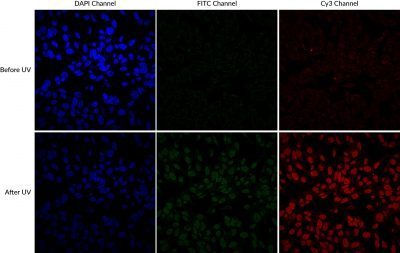DAPI and Hoechst dyes are routinely used in fluorescence microscopy as chromosomal or nuclear stains. They have similar excitation and emission spectra and show high specificity to DNA. Typically, on binding to DNA, these dyes are maximally excited in the UV range with emission in the blue range.
It has been reported that UV exposure can convert these dyes to forms that are excited by blue light and emit green fluorescence, leading to imaging artifacts and potentially confounding data interpretation in combinatorial / multicolor experiments. A recent study reports that these dyes can also be converted to forms that can be excited by green light and emit red fluorescence.

Photoconversion of DAPI to green and red fluorescence after exposure to UV light. Fixed and permeabilized HeLa cells stained with DAPI were imaged by confocal microscopy before or after exposure to mercury lamp excitation through the DAPI filter cube for 3 minutes.
To minimize potential photoconversion artifacts associated with these dyes see our Tech Tip Avoiding Artifacts from UV Photoconversion of DAPI and Hoechst.
To read the original article, click here.
Karg, T.J. & Golic, K.G. Chromosoma (2017) Photoconversion of DAPI and Hoechst dyes to green and red-emitting forms after exposure to UV excitation. https://doi.org/10.1007/s00412-017-0654-5
Learn more about Biotium’s trademark and classic Nuclear stains.

